

Boston Public Library
Country United States
Type Public
Established 1848
Location Boston, Massachusetts
Coordinates 42°20′57.55″N71°4′41.78″WCoordinates: 42°20′57.55″N 71°4′41.78″W
Branches 25
Collection
Size 24,079,520
Access and use
Circulation 1.7 million (FY 2011)
Population served 6,547,629
Other information
Budget $23,253,996
Director Amy Ryan, President[1]
Jeffrey B. Rudman, Chairman of the Board[2]
Website http://www.bpl.org
Phone number 1-(617)-536-5400
The Boston Public Library (est.1848) is a municipal public library system in Boston,Massachusetts, United States. It was the first publicly supported municipal library in the United States, the first large library open to the public in the United States, and the first public library to allow people to borrow books and other materials and take them home to read and use. The Boston Public Library is also the library of last recourse[3] of the Commonwealth of Massachusetts; all adult residents of the commonwealth are entitled to borrowing and research privileges, and the library receives state funding. The Boston Public Library contains 8.9 million books and A/V (approximately 24 million items encompassing all formats),[4] making it the second-largest public library in the United States, according to theAmerican Library Association.[5] In fiscal year 2009, the city of Boston spent 1% ($23,253,996) of its budget on the library – some $36 per person.[6]
Overview
According to its website, the collection of the Boston Public Library has grown to 23.6 million materials, which makes it one of the largest municipal public library systems in the United States. However, a vast majority of the collection is held in the library's central research library, which has 21.9 million volumes.[7] Between July 2010 and June 2011, the annual circulation of the BPL was 3,534,412.[8] Because of the strength and importance of its research collection, the Boston Public Library is a member of the Association of Research Libraries (ARL), a not-for-profit organization comprising the research libraries of North America. The New York Public Library is the only other public library that is a member of the ARL. The library has special strengths in art and art history (available on the third floor of the McKim building) and American history (including significant research material), and maintains a depository of government documents.
Included in the BPL's research collection are more than 1.7 million rare books and manuscripts. It possesses wide-ranging and important holdings, including medieval manuscripts and incunabula, early editions of William Shakespeare (among which are a number of Shakespeare quartos and the First Folio), the George Ticknor collection of Spanish literature, a major collection of Daniel Defoe, records of colonial Boston, the 3,800 volume personal library of John Adams, the mathematical and astronomical library of Nathaniel Bowditch, important manuscript archives on abolitionism, including the papers of William Lloyd Garrison, and a major collection of materials on the Sacco and Vanzetti case. There are large collections of prints, photographs, postcards, and maps. The library, for example, holds one of the major collections of watercolors and drawings by Thomas Rowlandson. The library has a special strength in music, and holds the archives of the Handel and Haydn Society, scores from the estate of Serge Koussevitzky, and the papers of the important American composer Walter Piston.
For all these reasons, the historian David McCullough has described the Boston Public Library as one of the five most important libraries in America, the others being the Library of Congress, the New York Public Library, and the university libraries of Harvard and Yale.
As of 2006, the Library has had staffing and funding levels for conservation below that of its peers: the BPL's staff of two full-time conservators is significantly less than the New York Public Library's thirty-five. Many colonial records and John Adams manuscripts are brittle, decaying, and in need of attention prompting the Library's acting Keeper of Rare Books and Manuscripts to say that "they are falling apart."[9] The library is considering cutting some of its branches and staff.[10]
History
In the mid-19th century, several people were instrumental in the establishment of the Boston Public Library. George Ticknor, a Harvard professor and trustee of the Boston Athenaeum, raised the possibility of establishing a public library in Boston beginning as early as 1826. At the time, Ticknor could not generate enough interest.
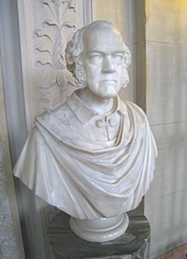
Bust of George Ticknor
In 1841, AlexandreVattemare, a Frenchman, suggested that all of Boston's libraries combine themselves into one institution for the benefit of the public.[11] The idea was presented to many Boston libraries, however, most were uninterested in the idea. At Vattemare's urging, Paris sent gifts of books in 1843 and 1847 to assist in establishing a unified public library. Vattemare made yet another gift of books in 1849.
Josiah Quincy, Jr. anonymously donated $5,000 to begin the funding of a new library. Quincy made the donation while he was mayor of Boston. Indirectly,John Jacob Astor also influenced the establishment of a public library in Boston. At the time of his death, Astor bequeathed $400,000 to New York to establish a public library there. Because of the cultural and economic rivalry between Boston and New York, this bequest prompted more discussion of establishing a public library in Boston.[12] In 1848, a statute of the Great and General Court of Massachusetts enabled the creation of the library. The library was officially established in Boston by a city ordinance in 1852.[13]
Eager to support the library, Edward Everett collected documents from both houses of Congress, bound them at his own expense, and offered this collection to help establish the new library. At the time of Everett's donation, George Ticknor became involved in the active planning for the new library.[14] In 1852, financier Joshua Bates gave a gift of $50,000 to establish a library in Boston. After Bates' gift was received, Ticknor made lists of what books to purchase. He traveled extensively to purchase books for the library, visit other libraries, and set up book agencies
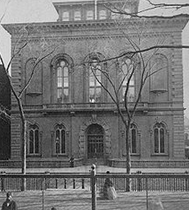
Public Library, Boylston Street, 1858–1895 (demolished 1899).
To house the collection, a former schoolhouse located on Mason Street was selected as the library's first home. On March 20, 1854, the Reading Room of the Boston Public Library officially opened to the public. The circulation department opened on May 2, 1854.
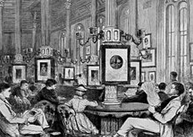
Reading Room in 1871 at the first Boylston Street building, the library's location between 1858 and 1895.
The opening day collection of 16,000 volumes fit in the Mason Street building, but it quickly became obvious that its quarters were inadequate. So in December 1854, the library's commissioners authorized the library to move to a new building on Boylston Street. Designed by Charles Kirk Kirby to hold 240,000 volumes, the imposing Italianate edifice opened in 1858. But eventually the library outgrew that building as well; in 1878, an examining committee recommended replacing it with a new one at another location.
By 1880, the Massachusetts legislature authorized construction of an even grander library building. A site selected was in Back Bay on Copley Square – the prominent corner of Boylston Street and Dartmouth Street, opposite Richardson's Trinity Church and near the first Boston Museum of Fine Arts. After several years of debate over the selection of the architects and architectural style for the new library, in 1887 the prestigious New Yorkfirm of McKim, Mead, and White was chosen to design the new library. In 1888, Charles FollenMcKim proposed a design based on Renaissance style which met approval from the trustees of the library, and construction commenced.
Central Library
The McKim building

McKim Building, Copley Square, Boston, 2005
Main article: Boston Public Library, McKim Building
The McKim building houses the BPL's research collection.
The Johnson building
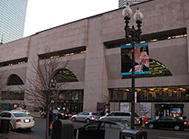
Johnson Building, Boylston St. near Copley Square, Boston, 2008
Designed by Philip Johnson, a late modernist addition (which somewhat anticipated postmodernist architecture) was built in 1967–1971 and opened in 1972. The Johnson building reflects similar proportions, and is built of the same pink Milford granite as the McKim building. Critics have likened it to a mausoleum, citing the small percentage of windows relieving the massive walls in its exterior façade.
Upon opening, the Johnson building became the home for the BPL's main circulating collection, which includes works in many languages. It also serves as headquarters for the Boston Public Library's 25 branch libraries.
Current services
Internet access
One of the features that the Boston Public Library offered first is free wireless internet. It is offered throughout the entire library and at all 25 branches, giving access to anyone who has a wireless enabled laptop and a library card to access the Internet. Plug-inEthernet access is also available in Bates Hall. The Boston Public Library also maintains several Internet databases providing either catalogue or full-text access to different parts of its collections, as well as to a number of proprietary databases. Public Internet access is also available to those without laptops, though this is in high demand and will be limited in duration if there are other patrons waiting.
Subscription databases
The Boston Public Library purchases access for its patrons to databases owned by the following companies:[15]
• Alexander Street Press
• Cengage Learning
• Gale (products include InfoTrac and MLA International Bibliography)
• EBSCO Industries
• H. W. Wilson Company (products include Readers' Guide Retrospective)
• Heritage Archives Inc. (products include Access Newspaper Archive)
• Internet Securities, Inc.
• Mergent, Inc.
• NewsBank
• Readex (products include Early American Imprints)
• NewspaperDirect
• OverDrive, Inc.
• Oxford University Press (products include Oxford English Dictionary)
• ProQuest (products include "Historical Newspapers" such as back issues of The Boston Globe and The New York Times)
• Thomson Reuters (products include Web of Science)
• UBM plc (products include Musical America)
Branch library system
In the latter half of the 19th century, the library worked vigorously to develop and expand its branch library system. Viewed as a means to extend its presence throughout the city, the branch system evolved from an idea in 1867 to a reality in 1870, when the first branch library in the United States was opened in East Boston. The library currently has 26 branches serving diverse populations in the city's neighborhoods.
• North End, Boston
• North End Branch, 25 Parmenter Street. A delivery station was first opened in 1882.[16] In 1913 the branch was located at 3A North Bennett Street in 1913. In 1965 it moved to its current building, designed by Carl Koch and Associates.[17]
• South End, Boston
• South End Branch, 685 Tremont Street. "Library service was established in the South End in 1877. The Branch was located in the Mercantile Library Association until 1879 when it was moved to the English High School. In 1904 the Branch relocated to 397 Shawmut Avenue and then again in 1923 to the John J. Williams Municipal Building at Shawmut Avenue and West Brookline Street. On June 7, 1971 the South End Branch Library moved to a new building at its present location, which was on the site of the original Mercantile building."[16][18]
• West End, Boston
• West End Branch, 151 Cambridge Street. "Library service in the West End was initiated in 1894 with the conversion of the Old West Church on the corner of Cambridge and Lynde Streets to library use. The West End Branch opened in February 1896. The West End Redevelopment Project necessitated closing the Branch in 1960. As part of the project a new building designed by Maginnis, Walsh and Kennedy opened in January 1968."[19]
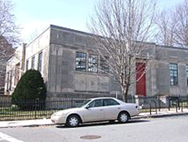
Faneuil Branch, Brighton, 2010
• Brighton
• Brighton Branch, 40 Academy Hill Road, Brighton. "When the town was annexed to Boston in 1874, the Brighton Social Library became a branch of the Boston Public Library. The same year the collection was moved from the Town Hall to a ornate library building named for Brighton notable, James Holton. In 1969 a new Brighton Branch building was opened. The building was designed by Norman C. Fletcher of the Architects Collaborative of Cambridge."[16][20]
• Faneuil Branch, 419 Faneuil Street, Brighton. "Built in 1931 to replace a temporary location on Brooks Street."[21] The branch is scheduled to close in autumn of 2010.[22]
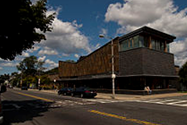
Honan-Allston Branch, 2009
• Allston
• Honan-Allston Branch, 300 North Harvard Street, Allston. "Allston's library service began in 1889 in a delivery station in Frank Howe's drugstore at 26 Franklin Street. ... In 1905, the Allston Reading Room at 354 Cambridge Street replaced the 16 year-old delivery station. A BPL librarian staffed the reading room. It became a full-service branch of the Boston Public Library in 1924. The branch moved to rented space at 161 Harvard Avenue in 1929. ... In 1981, amid statewide budget cuts, the Allston branch was closed. ... On January 19, 2000 ground was broken for the Allston Branch Library. Designed by Machado and Silvetti Associates ... the branch officially opened for business on Saturday, June 16, 2001. On March 13, 2003 the branch was renamed the Honan-Allston branch in honor of City Councilor Brian Honan."[23]
• Charlestown
• Charlestown Branch, 179 Main Street, Charlestown. "On January 7, 1862 the Charlestown Public Library was opened in the Warren Institution for Savings building. In planning for a year and a half the library opened with a catalog of 6,000 volumes. In 1869 the library moved to more spacious quarters in the new City Hall in City Square where it remained until 1913. The branch was then moved to the corner of Monument Square and Monument Avenue. ... In 1970 the Branch was moved to its current location."[16][24]



















